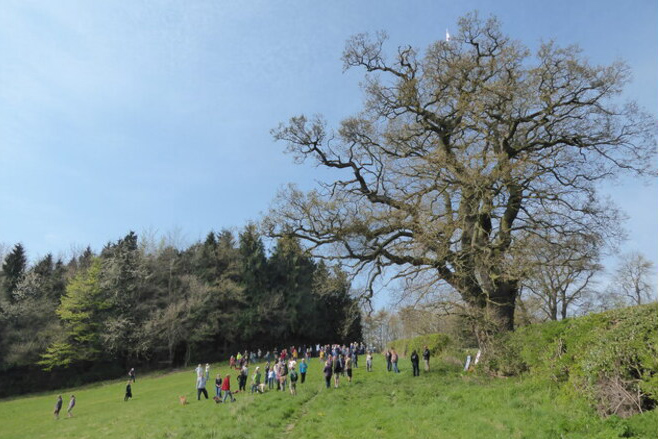‘Darwin’s Oak’ to be felled to make way for Shrewsbury Bypass
Darwin #Darwin

 North West Relief Road protesters meet at the ‘Darwin Oak’ in 2021. Image: Jeremy Bolwell/Wikicommons
North West Relief Road protesters meet at the ‘Darwin Oak’ in 2021. Image: Jeremy Bolwell/Wikicommons
By Stuart Butler
When Charles Darwin came up with the theory of evolution and survival of the fittest in the mid-1800s he probably couldn’t have envisaged that, nearly two hundred years later, and in a twisted fate of ‘evolution’, that a huge oak tree close to his childhood home would be felled to make way for the Shrewsbury Bypass.
The oak in question, which is locally dubbed ‘Darwin’s Oak’ is a 550-year-old freestanding oak with a girth some seven metres. The tree is very close to The Mount, which was the childhood home of Charles Darwin and the countryside around the house is said to have helped inspire Darwin’s interest in the natural world. Some say that the great scientist might have even known this particular tree. Alongside this venerable tree, eight other ancient trees are also due to fall to the axe.
The Shrewsbury Bypass, which is more correctly called the Shrewsbury North West Relief Road (NWRR), is an £80 million bypass that will link the northern and western parts of the town of 75,000. Those for the new road claim it will ease traffic congestion, free up road space and reduce town centre traffic, which would lead to reduced journey times, improved air quality and provide an economic boost for the entire county.
Enjoying this article? We have thousands more for you.
Get immediate access to over 1,000 Geographical magazines in our archive back to 1935.
Sign up today and you will soon be travelling back through time reading all our amazing features of the last eight decades PLUS… you also get to enjoy every new issue of Geographical each month going forward in both print and digital formats.
Simply press the button below to choose the perfect package for you.
But, a long campaign has been fought by activists and local people to save the trees, with those against the bypass saying that, as well as requiring the felling of such venerable trees, the new road will cut through a rare green space that extends almost into the heart of the town. In 2021, Rob McBride, one of the leading campaigners to save the trees, said, ‘Standing under this tree was a moment where you think: ‘What are we doing to our planet?’ Councils are really lagging behind current thinking. Darwin may have sat under this tree and considered the evolution of man. The people making the decision on this road are dinosaurs.’
 Statue of Charles Darwin at the Natural History Museum, London.
Statue of Charles Darwin at the Natural History Museum, London.
Despite this opposition, at the end of October, Shropshire county council’s eleven member planning committee approved the felling of the trees by a narrow margin of six votes to five.
The Woodland Trust, which works to safeguard woodlands and ancient trees in the UK, claims that the approval of the bypass and felling of these trees ignores national planning rules that are in place to protect ancient trees except for in exceptional circumstances. Woodland Trust spokesperson Jack Taylor, said: ‘The narrow approval of the Shrewsbury North West Relief Road is a dark day for the environment and our natural heritage as it threatens the loss of this living legend, numerous other irreplaceable veteran trees, and will damage nearby ancient woodland. The UK needs better protection for these cathedrals of nature, before they are condemned to history.’
Stay connected with the Geographical newsletter!
In these turbulent times, we’re committed to telling expansive stories from across the globe, highlighting the everyday lives of normal but extraordinary people. Stay informed and engaged with Geographical.
Get Geographical’s latest news delivered straight to your inbox every Friday!
Although the council has approved the felling of the trees, local campaigners hope they can reverse the decision. A petition asking the council to reconsider their decision has been launched.
Related articles: